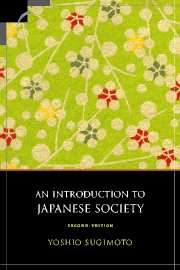Book contents
- Frontmatter
- Contents
- List of Figures
- List of Tables
- Preface to the First Edition
- Preface to the Second Edition
- Map of Japan
- 1 The Japan Phenomenon and the Social Sciences
- 2 Class and Stratification: An Overview
- 3 Geographical and Generational Variations
- 4 Varieties in Work and Labor
- 5 Diversity and Unity in Education
- 6 Gender Stratification and the Family System
- 7 Minority Groups: Ethnicity and Discrimination
- 8 Collusion and Competition in the Establishment
- 9 Popular Culture and Everyday Life
- 10 Friendly Authoritarianism
- References
- Index
9 - Popular Culture and Everyday Life
- Frontmatter
- Contents
- List of Figures
- List of Tables
- Preface to the First Edition
- Preface to the Second Edition
- Map of Japan
- 1 The Japan Phenomenon and the Social Sciences
- 2 Class and Stratification: An Overview
- 3 Geographical and Generational Variations
- 4 Varieties in Work and Labor
- 5 Diversity and Unity in Education
- 6 Gender Stratification and the Family System
- 7 Minority Groups: Ethnicity and Discrimination
- 8 Collusion and Competition in the Establishment
- 9 Popular Culture and Everyday Life
- 10 Friendly Authoritarianism
- References
- Index
Summary
Elite Culture and Popular Culture
Japanese society embraces a rich variety of cultural forms which reflect its tradition, stratification, and regional stretch. As in any society, the primary bearers of high and popular forms of Japanese culture can be differentiated along class lines. In the main, a small number of elites relish such traditional cultural styles as classic literature, flower arrangements, tea ceremonies, noh and kyōgen plays, koto music, bunraku puppet shows, and classic Japanese buyō dancing. They also enjoy Western classic music, opera, art exhibitions, and theatrical performances.
These images tend to mirror the elite culture, which is not that of most Japanese. Ordinary citizens of Japan adopt much more informal, vulgar, unassuming, ostentatious, and down-to-earth cultural styles. In contrast to the organized subculture of companies and schools, Japan's city life abounds with hedonism, intemperance, and overindulgence. The Japanese also enjoy various forms of traditional grassroots culture, ranging from colorful agrarian festivals to local folk dances. Further, Japan has a range of counter-cultural groups even though their public visibility may be limited.
Whilst Japan's popular culture is multifarious, it represents the ways of life the common people enjoy and share. For analytical purposes, this chapter divides popular culture into three categories: mass culture, which has spread with the expansion of the consumer market and the development of mass communication; folk culture, which has been based upon conventions, mores, and customs of the indigenous tradition; and alternative culture, which a small number of ordinary citizens generate spontaneously as counterculture challenging the cultural status quo.
- Type
- Chapter
- Information
- An Introduction to Japanese Society , pp. 244 - 270Publisher: Cambridge University PressPrint publication year: 2002

